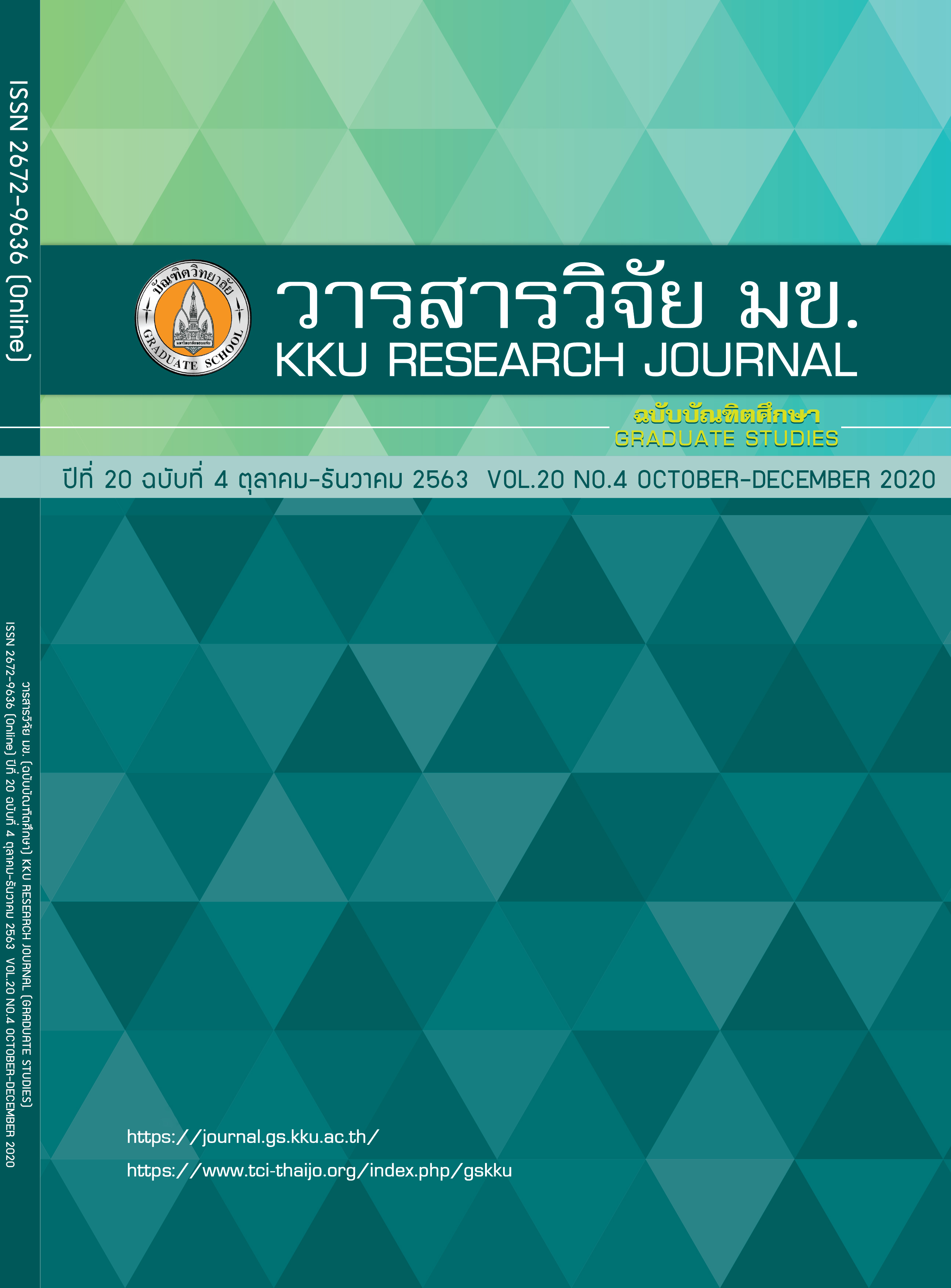Characterization of Biodegradable Packaging Film Based Riceberry Rice
Keywords:
Biodegradable, Edible film, Riceberry riceAbstract
The objective of this research was to study the properties biodegradable packaging film based Riceberry rice. The film prepared from 6 ร้อยละโดยน้ำหนัก Rice berry rice starch, 25ร้อยละโดยน้ำหนัก glycerol, 3 ร้อยละโดยน้ำหนัก malic acid (MA) and 0-9 ร้อยละโดยน้ำหนัก of polyvinyl alcohol (PVA). Based on the results, the color of films tested by HunterLab ColorQuest XE showed the same range of colors when PVA content in film increased. The thickness, total soluble matter and water vapor transmission tended to increase with increasing PVA content. The release of antioxidants of films was also observed in three food simulants such as distilled water, ethanol 10%, and ethanol 95%. The antioxidant agents of riceberry rice starch showed a similar trend of releasing in all food simulants. The maximum tensile strength of film was observed in film containing 3 ร้อยละโดยน้ำหนัก of PVA. The obtained films were conducted to test as tomato packaging. The film can reduce weight loss and wrinkle of tomato. These results revealed that the packaging film based Riceberry rice starch and PVA have high potential to developed to be biodegradable packaging for foods
References
Huber K, Embuscado M. Edible Films and Coatings for Food Applications. Edible Films and Coatings for Food Applications: , ISBN 978-0-387-92823-4. Springer-Verlag New York, 2009.
Thessrimuang N, Prachayawarakorn J. Characterization and Properties of High Amylose Mung Bean Starch Biodegradable Films Cross-linked with Malic Acid or Succinic Acid. J Polym Environ. 2019;27(2):234–244.
Hosseini SF, Rezaei M, Zandi M, Farahmandghavi F. Bio-based composite edible films containing Origanum vulgare L. essential oil. Ind Crops Prod. 2015;67:403–413.
Zanela J, Olivato JB, Dias AP, Grossmann MVE, Yamashita F. Mixture design applied for the development of films based on starch, polyvinyl alcohol, and glycerol. J Appl Polym Sci. 2015;132(43).
Olivato JB, Grossmann MVE, Bilck AP, Yamashita F. Effect of organic acids as additives on the performance of thermoplastic starch/polyester blown films. Carbohydr Polym. 2012;90(1):159–164.
Wu J, Chen S, Ge S, Miao J, Li J, Zhang Q. Preparation, properties and antioxidant activity of an active film from silver carp (Hypophthalmichthys molitrix) skin gelatin incorporated with green tea extract. Food Hydrocoll. 2013;32(1):42–51.
Yoon SD, Chough S-H, Park H-R. Effects of additives with different functional groups on the physical properties of starch/PVA blend film. J Appl Polym Sci. 2006;100(5):3733–3740.
Debeaufort F, Voilley A. Lipid-Based Edible Films and Coatings BT - Edible Films and Coatings for Food Applications. In: Huber KC, Embuscado ME, editors. New York, NY: Springer New York; 2009. p. 135–168.
Ounkaew A, Kasemsiri P, Kamwilaisak K, Saengprachatanarug K, Mongkolthanaruk W, Souvanh M, et al. Polyvinyl Alcohol (PVA)/Starch Bioactive Packaging Film Enriched with Antioxidants from Spent Coffee Ground and Citric Acid. J Polym Environ. 2018;26(9):3762–3772.
Cano AI, Cháfer M, Chiralt A, González-Martínez C. Physical and microstructural properties of biodegradable films based on pea starch and PVA. J Food Eng. 2015;167:59–64.
Hu Y, Topolkaraev V, Hiltner A, Baer E. Measurement of water vapor transmission rate in highly permeable films. J Appl Polym Sci. 2001;81(7):1624–1633.
Brand-Williams W, Cuvelier ME, Berset C. Use of a free radical method to evaluate antioxidant activity. LWT - Food Sci Technol. 1995;28(1):25–30.
Bourtoom T, Chinnan MS. Preparation and properties of rice starch–chitosan blend biodegradable film. LWT - Food Sci Technol. 2008;41(9):1633–1641.
Srirachya N, Boonkerd K, Kobayashi T. Effective elongation properties of cellulose–natural rubber composite hydrogels having interconnected domain. J Elastomers Plast. 2019;0095244319849699.
Colivet J, Carvalho RA. Hydrophilicity and physicochemical properties of chemically modified cassava starch films. Ind Crops Prod. 2017;95:599–607.
Guimarães M, Botaro VR, Novack KM, Teixeira FG, Tonoli GHD. High moisture strength of cassava starch/polyvinyl alcohol-compatible blends for the packaging and agricultural sectors. J Polym Res. 2015;22(10):192.
Tampau A, González-Martínez C, Chiralt A. Release kinetics and antimicrobial properties of carvacrol encapsulated in electrospun poly-(ε-caprolactone) nanofibres. Application in starch multilayer films. Food Hydrocoll. 2018;79:158–169.
López-de-Dicastillo C, Gómez-Estaca J, Catalá R, Gavara R, Hernández-Muñoz P. Active antioxidant packaging films: Development and effect on lipid stability of brined sardines. Food Chem. 2012;131(4):1376–84.
Yun Y-H, Na Y-H, Yoon S-D. Mechanical Properties with the Functional Group of Additives for Starch/PVA Blend Film. J Polym Environ. 2006;14(1):71–78.
Reddy N, Yang Y. Citric acid cross-linking of starch films. Food Chem. 2010;118(3):702–711.



